This Is A Kendama
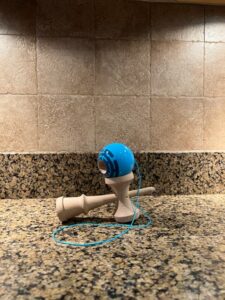
The Kendama was invented between the years 17th and 18th century and it evolved from the French bilboquet otherwise know as the cup and ball game. The Kendama Is a Japanese skill toy that was designed to be addicting challenge of ones hand eye coordination, reaction time, and focus. The Kendama Is played by holding the Ken (Handle) and swinging the Tama (ball) and landing it on different cups or the spike of kendama.
The Parts Of A Kendama
The Ken (Handle or Stick)
The Ken is the framework for a kendama. Firstly the Ken has a handle for holding the kendama and performing most tricks. Secondly every piece of the kendama attaches to the ken in order to make a complete kendama. The sarado/cups slide over the spike of the ken and pressure fit over the hole where the string is tied to the ken and the tama(ball) is tied to then end of the string. The ken also has the bottom cup (chūzara) at the end of the handle section and the smaller skinny section or the tip of the ken functions as the kensaki more well know as the spike. In conclusion the ken is the back bone of the kendama and holds everything together.
The Sarado (Cup Body or Cups)
The sarado or cup body consists of a Kozara (small cup) on one end, and an Ozara (big cup) on the other, with small holes on either side for the string to pass though the sarado. The hole in the center of the Sarado is where the spike side of the ken is inserted in order to assemble the kendama.
The Tama (Ball)

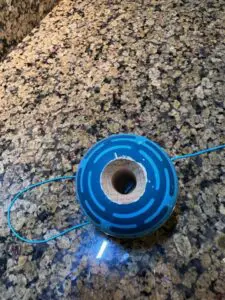
The tama is the ball of the kendama and it consists of a hole on top for a string to be tied and a larger hole know as the ana. The ana or hole of the tama is used to land on top of the spike of the ken. In the rightmost photo of the tamas if you look closely into the hole of the tama or the Ana you can see where the string is tied with the small bead or sometimes a bearing bead is used as well.
The string Bead Or Bearing Bead
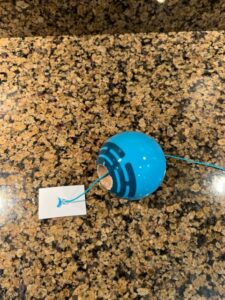
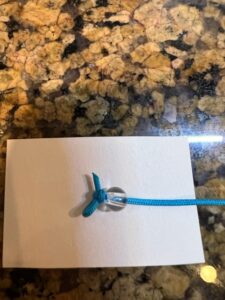
In these photos they highlight how the string passes thought the top of the kendama and is knotted at one end with a small bead to prevent the string from passing though the hole. The bead plays an extremely important role in the functioning of the kendama. When the tama is hanging on the end of the string the bead reduces the friction between the string and the tama and allows the tama to spin. Having the Tama spin freely keeps the string from getting tangled while the kendama is being used. Often times a bearing is used in place or with the bead in order to reduce the friction between the string and tama even more and allow for nearly frictionless spinning.
What Is Kendama?
A kendama is a very simple toy. That’s made up of three different cups, the spike, and the ball which has a hole in it. With this seemingly simple toy people do tricks, but what you might not have expected of this very addictive toy is that it has an entire economy around it.
Professional players and for a brief second it got popular in the world of hip-hop. In today’s post we are going to explore how the hell that all happened. So our story begins back in the 1600s in France. Now It’s a weird one, because many people believe that kendama’s origins are in Japan, but Kendama scholars argue that the kendama actually came from France in the 1600s there’s even an indication that it may have come from Greece or China. But for the sake of this post, let’s just give it to France. The Kendama that existed in France was much different to the one that we have here.
Now. If you ever play a Kendama around your gran dad he’s gonna say yeah, we used to have that as a kid. It was called ball and cup uh no grand dad this is a Kendama. However, your grand dad is right. Originally the bilboquet was a cup and ball game. It did not have all the different cups and the spike like a kendama would it would literally have just been the ball and the cup. When people eventually realized they needed to level up the toy.
This happened in the Edo period, which was between 1603 and 1863, and It’s believed to have originated in the Japanese city of Nagasaki. This was because Nagasaki was the only Japanese city at the time to allow foreign trade, and, at this time the Kendama was primarily a drinking game.
I can do that. Give it. However, it wasn’t until the Meiji period that the Japanese ministry of education would introduce the Kendama in a report on children’s education in 1876. So from what I could understand, they actually encouraged Kendama in schools and I’m pretty sure I got a detention for playing with my Kendama in school. From here, Kendama took off amongst young people in japan in 1919, the precursor to today’s Kendama went on sale under the name.
The Nitchi-Getsu Ball and it became a huge hit. The Nitchi-Getsu ball, was different to the ball and cup that was popular before they had new cups and new options, which allowed a massive variety of tricks to be done. All the way up to 1989 we would see tons of variations of what we call the Kendama now with different shapes, cups, different sizes, etc. After the end of world war II in 1945, kendama’s were super common and they were typically sold in sweet shops, but it wasn’t until 1975, where a children’s author by the name of Fujiwara Issei, founded the Japan Kendama A Association or the JKA, which would go on to standardize the kendama as well create rules for a competitive format.
With this rule set and competitive specification for the Kendama Kendama grew into a serious sport across japan and there would be a ton of competitions within schools, and these were like serious competitions. They weren’t just some crappy after school club. If you won one of these competitions, the minister of education would give you an award. Between the 80s to the 90s kendama was officially popping in Japan, but the rest of the world knew nothing about it. In the western world during the 90s, the things that were popular were like yo-yo and juggling. They were like the skill toys that were popular in the west.
The 2000s was a real time to be alive with the rise of the internet and viral videos. The Kendama for the first time would leave the borders of japan and go international. In the early days of YouTube we would see videos pop up of these young kids playing Kendama. In 2006, a company by the name of Kendama USA was founded and kendama started to grow in the United States. But, interestingly, it wasn’t in schools. like the many endless fads of the 2000s like Pokémon cards, When kendama Came to the United States it rather interestingly found its home in action sports like skateboarding, snowboarding, flipping, BMX, and rollerblading.
For some reason, there was something about Kendama that these sporting communities absolutely loved. I’m going to speak from my personal experience. My journey in the world of Kendama started in 2010 at the same time I got into the sport of parkour.
Kendama’s were everywhere in every training session. You would see a Kendama and, you couldn’t escape it, It was the go-to activity that you would do at the end of a parkour session. what I find interesting as well is. Why do parkour, BMX, snowboarding, rollerblading also take a particular interest in the Kendama?
Was there is link between these kinds of sports and Kendama it isn’t the risk-taking or adrenaline side that gets people into Kendama. It’s something much simpler than that, and that is the feeling of pulling off a trick or a sequence of tricks and doing it perfectly. You see all of these action sports. I mentioned they have a commonality amongst them they are often practiced in runs or lines moves in which you meticulously perfect. That feeling you get when you, when you do the trick really perfectly is pretty much the exact same feeling you get when you land a trick on a kendama. When I first picked up the Kendama, I recognized the feeling instantly after landing my first spike.
The moment that you hear the sound of the spike. That’s when the addiction sets in. I remember specifically, after one long day of doing parkour, all of us went and stayed at a friend’s house and very quickly the Kendama came out, and someone had set a challenge. It was you can’t sleep until you landed a certain trick which was lighthouse.
And no word of a lie one of my friends stayed up till 3 a.m. trying to get this one trick .The Kendama is effectively a condensed version of action sports because of the tricks requiring mass amounts of concentration and hand eye coronations to land so its very rewarding when landed just like landing your first flip in parkour.
You might be trying one trick and you try it like a hundred plus times, you battle for it, and eventually you land it. the sense of relief from that is insane and, the euphoria that you’ve done it is very similar to action sports and, if you’re reading this and you’ve never done an action sport, you’ve never done skateboarding or anything like that. I can still imagine you know what that feeling is, its like if you’ve ever thrown a ball into a cup from a distance and you’ve spent like 10-15 minutes trying to make the shot, and then you eventually get it. when you make the shot, that is feeling right there when you make the shot. That is basically what Kendama is in a nutshell, and It’s my belief that people who are into action sports probably have some kind of predisposition to loving that feeling.
Over time the Kendama would get very popular across the world. In 2008, Germany held the first ever international Kendama event called the Kendama open. The Kendama open would then go to the USA in 2013 and then, finally, the first ever Kendama world cup in 2014.
It was becoming a big deal and, with this rise in popularity that was bred through these small sporting communities, one person would come along and completely revolutionize the Kendama, and that person is Adam 22. Adam 22 is the owner of a podcast called No Jumper throughout the 2010s and specifically the SoundCloud rap era. No jumper was massive and they would have tons of interviews with very famous rappers.
You would see people like lil peep, trippy red, lil pump. All of these kinds of famous people, before they were famous. No Jumper, would catch these rappers before they really blew up and become cultural icons. Adam 22 was a tastemaker, but before all of this Adam 22 was known in the world of BMX, he was a pretty good BMX himself, but he was known as a BMX filmier.
We first started to see Adam playing with a kendama in one of his vids around 2017. It would appear in tons of no jumper content and if we look at google trends, we can see a massive spike for the term kendama around 2017.
And at this point, Adam 22 actually started to incorporate Kendama into his personal brand. So I was really curious to find out from Adam 22 himself how he found out about Kendama. Amazingly I reached out to the boss, who asked his wife, Riley Reid, to contact Adam 22.
Here Is Adams 22’s story about how he discovered kendama.
About 10 or 11 years ago, a bunch of like snowboarders and skiers. They were out in japan and they would see many kids just play with it or even like businessmen, and some like older people, they’ll play kendama, but in a really simple way. Then these, action sporty American guys found out about it and they started working with it in a more creative freestyle. Like a skateboard or snowboard, inspired way of thinking about it.
Then it just sort of spiraled from there, some of these guys that were into it just kept getting more and more advanced and they started brands and they started to try to get more people into it from here.
Adam would basically introduce rappers to kendama every time they would come to the store to do a podcast or a vlog. You would quite often see Adam in his vlogs giving people a kendama and getting them to try and land a trick. Kendama would become part of the aesthetic and brand of no jumper. These rappers were massive names in pop culture and for a short moment, Kendama was the cool thing.
This Japanese kid’s toy had now become cool, more and more kendama’s were being made with these really cool designs, and sometimes people would just have them as kind of like swag or a collection. It was the aesthetic and from this the competitions were getting bigger. More and more pro Kendama players existed, and now there was a full-blown economy around this kid’s toy that weirdly kids didn’t really play with.
However, eventually this major fad in 2017 would have to die down a little bit, so they are definitely not as popular as it was in 2017, but kendama is still massive. It’s still going strong with major competitions, and pros, and new people getting into it. Ever since the SoundCloud rap era came to an end, you don’t really see it amongst rappers anymore, but the core audience and fan base of Kendama is still very strong.
The big brands that exist like sweets Kendama’s, Kendama London, and Krom, who actually went on to collaborate with a parkour brand called Ashigaru.
I don’t exactly know the goings on in the school playground anymore, but I don’t think they ever took off in the same way that yo-yos did in the 90s. So it does lead me to think that that is a possibility for the future of Kendama. It’s been a pretty wild ride for the Kendama all the way from the 1600s as the ball and cup game and then eventually the kendama.
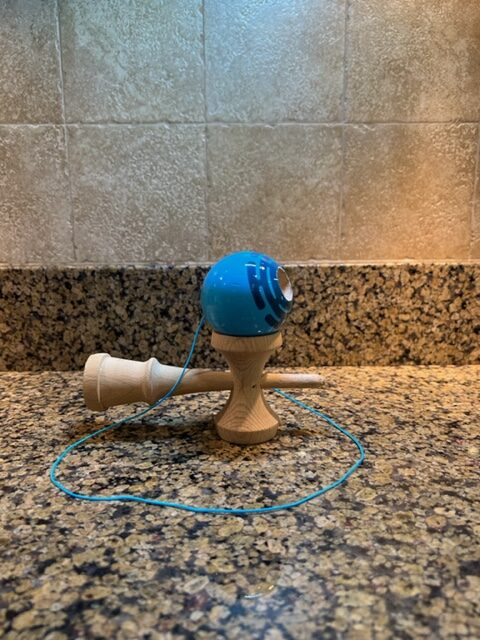
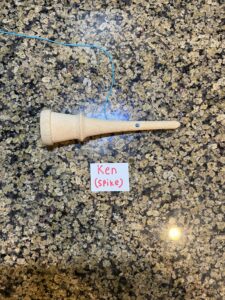
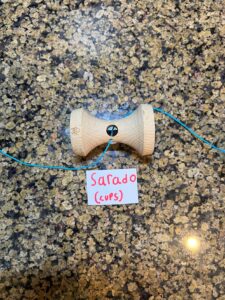
[…] Read More: What is a Kendama? […]
[…] Read More Here: What’s a Kendama […]
[…] this Post, I am going to introduce you to The Pill which is a modern innovation on kendama. In one sense, the pill is just a simplified kendama. Many people think of it as training wheels, […]
[…] Learn More Here What is a kendama […]
[…] Read more about the anatomy of a kendama […]